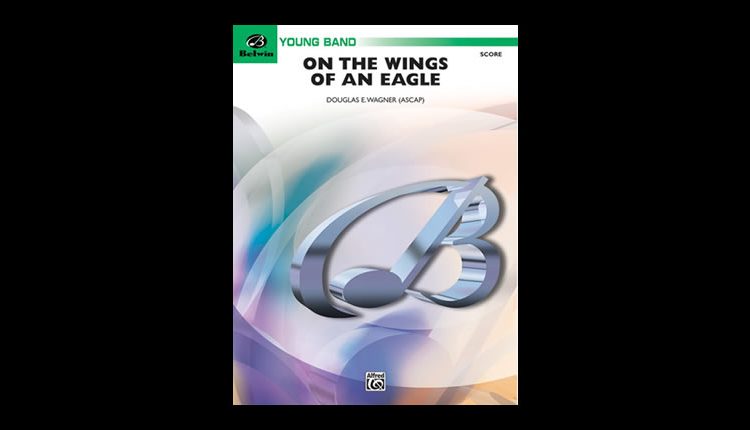ON THE WINGS OF AN EAGLE
COMPOSER: Douglas E. Wagner
PUBLISHER: Alfred Music
LENGTH: 2:00
GRADE LEVEL: Young Band
Expansive harmonies and subtle counterpoint characterizes this “soaring “ballad. The suggested tempo is marked quarter note mm=63, and there are two occasions where the composer suggests that the tempo move ahead a bit more.
During a brief introduction of four measures, the baritone horn, clarinets, horns and saxophones present a suggestion of the main theme’s rhythm. A pedal point on the note F anchors the moving lines and adds stability.
At measure five, the trumpets in unison, with a moving line in the high woodwinds and low brass, warmly announces the theme.
At measure 13, the theme continues in the trumpets, with a counter line played by the flute and oboe in octaves. The bassoons, alto saxophone, horn, and baritone horn bring forth another moving line. We have three lines moving at different speeds, which work quite well in creating a warm, expressive sonority. We can envision flight.
A contrasting theme begins in measure 19 in the flute and oboe, tastefully imitated by orchestra bells, adds a delicate daub of color.
At measure 23, the composer desires the tempo to “move ahead” a bit for variety and an increase in emotional feeling. The trumpets majestically state the theme, playing mostly in parallel thirds, with full, expansive chords resonating in the low brasses.
At measure 31 the tempo returns to “Tempo I” with the main theme played by the flute, oboe, and horn, combined with a counter line played by the clarinets, bassoons, alto saxophones, and orchestra bells.
From measure 35 to the end, the piece “moves ahead” a bit more with a modification of the main theme, with the dynamic shadings changing the musical landscape. The insertion of two fermatas just prior to a molto ritard leads to a dramatic final chord marked sfp with a crescendo to a fortissimo.
The themes are warm and appealing with interesting musical background lines played by the horns, baritone horn, bassoons, and tenor saxophone. The flute and oboe are tastefully handled throughout in the use of background counter lines.
The chord progressions are whole step, and circle of fifths, with smoothly handled bass lines. The horns play throughout the piece, but do have some very dramatic contrapuntal lines. The second clarinets are written below the break. There is an obvious emphasis on harmonic richness throughout this ballad.
This expressive piece is valuable for teaching legato style and interpretation. All the players have interesting parts to play. The instrumental combinations create tonal coloring and add a high degree of interest to the composition. The moving background lines are tastefully handled and are very effective.
I highly recommend this piece for Jr. High School or easy Sr. High.Vince Corozine Music , Author of “Arranging Music for the Real World” by Mel Bay Publications
Web: www.vincecorozine.com


